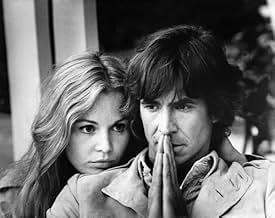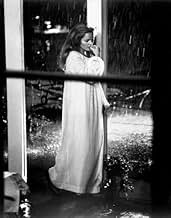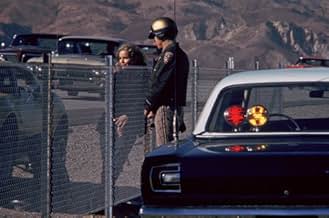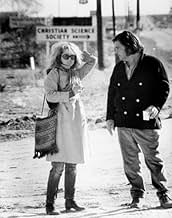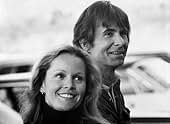Ajouter une intrigue dans votre langueA Hollywood actress undergoes a psychic breakdown and recalls the traumatic events which led to her stay at a sanitarium.A Hollywood actress undergoes a psychic breakdown and recalls the traumatic events which led to her stay at a sanitarium.A Hollywood actress undergoes a psychic breakdown and recalls the traumatic events which led to her stay at a sanitarium.
- Réalisation
- Scénario
- Casting principal
- Récompenses
- 1 victoire et 1 nomination au total
Avis à la une
The movie Play It as It Lays is, admittedly, not everyone's cup of tea. Even the book--as much as I liked it--was a hard sell to friends and family; most, especially those living outside the Southern California forcefield, simply could not grasp the essential Los Angeles flavor of Didion's dry economical language. The language of the Industry is spot-on (for a change) as are the depictions of the unusual alliances and estrangements of the characters in the film. One person I know who hated the film complained that it was too "faggy" and not like the real Hollywood at all (this person lives in Tucson); the B.Z. and Maria relationship at the heart of this movie may seem bizarre and pointless to auslanders, but it certainly reminded me of real life in LA circa 1972. Also of note is Tammy Grimes' performance as B.Z.'s wife--she got so many of the good lines ("Oh God my face--I can really see a difference"; "in what?"; "skipping my Lazslo for one day.") This movie should be available in VHS/DVD; does anyone know why it's been ignored? I'd love to know.
Jagged, pessimistic view of the denizens of Hollywood, circa 1972. Troubled movie actress, conflicted over her recent divorce from her director-husband, is finding herself slowly becoming alienated from her show business circle; unselfconscious--and still hopeful things will work themselves out--she's unable to reconnect the lost threads of her past, and begins feeling numb and catatonic. Joan Didion's novel, adapted by Didion with her husband, John Gregory Dunne, has been entrusted to director Frank Perry, and he digs right to the core of this material. It isn't just the bitchiness of the business that is wearing our heroine down, it's the blasé apathy with which the business is handled that strikes her both curious and sad. Tuesday Weld gives a deliberately low-key, thoughtful performance in the lead; her Maria Wyeth can be as tart in her repartee as her competitors (she's no shrinking violet), and yet the numbness she feels creeping in frightens her. Weld is reunited with her "Pretty Poison" co-star Anthony Perkins, excellent as a gay producer trapped in a business-marriage to a woman. The two share a quietly devastating scene in a motel room near the end that brings the narrative full circle while also showing the depth of feeling in the material (some may think the film superficial, but this is deceptive). The quicksilver editing may actually be too canny and clever, with many scenes seeming smug or half-finished (and usually ending on a rueful line or look). I think Perry means to shake the audience up with his herky-jerky structure, but perhaps the movie (with its feeling of an open wound) left too many viewers behind. A forgotten picture, it remains one of the most acidic portraits of lotus land ever captured on film. ***1/2 from ****
After having seen this film on Sundance several times, I will now have to read the book. This film is an excellent portrayal of a career/mid-life crisis, in its most existential form.
Not to be morbid, but if you ever read in the headlines about someone who "has it all" and just committed suicide,(and you are still mystified by this) you should watch this film. It is a version of "The Bell Jar" as experienced in Hollywood. Tuesday Weld and Tony Perkins are perfectly cast as two disaffected souls; tired of work, film, travel, meaningless trips to Vegas.
The photography is erratic and juxtaposed upon different layers of Weld's confused life. She goes to get an abortion, and the friend driving her starts talking about what sports car he should buy.
There are some beautiful scenes in the desert where her ex-husband is filming. The starkness, and randomness of life there are palpable. The relationship with her ex is a bit jumbled- but then, so is real life; nothing is clearly delineated; the dialogue is evasive and ominous.
The scene with Perkins and Weld alone are worth watching. She lulls him to sleep, talking about making preserves and relish, as he finally succumbs to the Seconal he carries around. The film, however, is not over-the-top; it is a believable account of people's lives- they just happen to be living in Hollywood, their lives are insular, but still not protected from despair. 9/10
Not to be morbid, but if you ever read in the headlines about someone who "has it all" and just committed suicide,(and you are still mystified by this) you should watch this film. It is a version of "The Bell Jar" as experienced in Hollywood. Tuesday Weld and Tony Perkins are perfectly cast as two disaffected souls; tired of work, film, travel, meaningless trips to Vegas.
The photography is erratic and juxtaposed upon different layers of Weld's confused life. She goes to get an abortion, and the friend driving her starts talking about what sports car he should buy.
There are some beautiful scenes in the desert where her ex-husband is filming. The starkness, and randomness of life there are palpable. The relationship with her ex is a bit jumbled- but then, so is real life; nothing is clearly delineated; the dialogue is evasive and ominous.
The scene with Perkins and Weld alone are worth watching. She lulls him to sleep, talking about making preserves and relish, as he finally succumbs to the Seconal he carries around. The film, however, is not over-the-top; it is a believable account of people's lives- they just happen to be living in Hollywood, their lives are insular, but still not protected from despair. 9/10
For a short while, in the days when it was still possible; director Frank Perry valiantly attempted the making of an American art film depicting existential despair in the European tradition of Bergman and Antonioni. "The Swimmer" and "Play It As It Lays" remain fine examples of his work but both found little support within the industry and unsurprisingly failed to reach audiences. While "The Swimmer" is available on video and DVD owing to the clout of Burt Lancaster, the superior "Play It As It Lays" has vanished without a trace. Occasionally copies do surface but always of poor quality.
In "Pretty Poison" the curious but clearly evident chemistry between Tuesday Weld and Anthony Perkins did not go unnoticed. In "Play It As It Lays" this odd affinity is elevated to the level where by merely looking at each other, the total understanding and empathy these characters possess is revealed. The relationship is extremely tender, while asexual. These are soul mates sharing a common despair, which each will deal with in different ways.
One can only surmise as to the source of this truly rare chemistry. Tuesday Weld and Anthony Perkins had both been attractive young performers who were being groomed for a Hollywood stardom that had little, if not nothing, to do with the interesting, somewhat different personalities behind the image. Weld was put through such vehicles as "Rock Rock Rock" and "Sex Kittens Go to College" while an uncomfortable looking Perkins did "Green Mansions" and "Tall Story". The astute Hitchcock, a master at utilizing actor's personalities would stamp Perkins career until the end by casting him in "Pyscho". Weld and Perkins would always be outsiders in a system which largely misunderstood them.
"Play It As It Lays" is one of the few films in which both Weld and Perkins seem totally comfortable in their roles. They play their parts with great ease and utter conviction. It's as if they are not acting at all; they simply are Maria Wyeth and B.Z.. Surely there's no higher praise for actors. Their final scene together is unparalleled.
Adam Roarke too, reveals a power and intelligence missing in his previous films amongst which had been biker movies much like "Angel Beach" which his character directs. It's as if director Frank Perry is consciously affording the actors a chance to do something they really want to do, in contrast to many of their previous roles. They respond with performances containing a core of truth making "Play It As It Lays" a fascinating film.
Joan Didion's novel has been faithfully adapted. The emptiness of affluent America, or more precisely California, finds expression in the jarringly edited, puzzle like assembled work. By setting this piece in the world of filmmaking Didion not only sheds light on the void in the individual's life, but on the barrenness of the American film making process itself; something that all connected with "Play It As It Lays" would have close knowledge of, and clearly suffered from.
If ever a movie needed to be resurrected and reappraised it's this genuine rarity.
In "Pretty Poison" the curious but clearly evident chemistry between Tuesday Weld and Anthony Perkins did not go unnoticed. In "Play It As It Lays" this odd affinity is elevated to the level where by merely looking at each other, the total understanding and empathy these characters possess is revealed. The relationship is extremely tender, while asexual. These are soul mates sharing a common despair, which each will deal with in different ways.
One can only surmise as to the source of this truly rare chemistry. Tuesday Weld and Anthony Perkins had both been attractive young performers who were being groomed for a Hollywood stardom that had little, if not nothing, to do with the interesting, somewhat different personalities behind the image. Weld was put through such vehicles as "Rock Rock Rock" and "Sex Kittens Go to College" while an uncomfortable looking Perkins did "Green Mansions" and "Tall Story". The astute Hitchcock, a master at utilizing actor's personalities would stamp Perkins career until the end by casting him in "Pyscho". Weld and Perkins would always be outsiders in a system which largely misunderstood them.
"Play It As It Lays" is one of the few films in which both Weld and Perkins seem totally comfortable in their roles. They play their parts with great ease and utter conviction. It's as if they are not acting at all; they simply are Maria Wyeth and B.Z.. Surely there's no higher praise for actors. Their final scene together is unparalleled.
Adam Roarke too, reveals a power and intelligence missing in his previous films amongst which had been biker movies much like "Angel Beach" which his character directs. It's as if director Frank Perry is consciously affording the actors a chance to do something they really want to do, in contrast to many of their previous roles. They respond with performances containing a core of truth making "Play It As It Lays" a fascinating film.
Joan Didion's novel has been faithfully adapted. The emptiness of affluent America, or more precisely California, finds expression in the jarringly edited, puzzle like assembled work. By setting this piece in the world of filmmaking Didion not only sheds light on the void in the individual's life, but on the barrenness of the American film making process itself; something that all connected with "Play It As It Lays" would have close knowledge of, and clearly suffered from.
If ever a movie needed to be resurrected and reappraised it's this genuine rarity.
This film, as the previous reviewers have said, is a real gem, namely for two reasons. First off, it is basically a character study of an individual who has been consumed by the lifestyle which she has adopted for herself. In the part of this tortured person, Tuesday Weld gives an exceptional performance. Her body language and facial expressions all convey the feeling of a person lost in this world that she has come to loathe. Anthony Perkins is also excellent in his role of B.Z. and he, and Weld counteract with each other beautifully.
The other main reason why this film is so intriguing, is the way it is edited and pieced together. The viewer basically goes from one scene to the next without any serious concern for continuity. Because of this fractured, choppy approach to the storytelling, some really impressive sequences are pulled off simply, yet effectively. There is one particularly impressive sequence involving Weld's character driving down a freeway, while a camera above pulls back to show the twisted, snake-like formation of the southern California freeway system. There is also the final scene, with it's haunting final message, which is certain to linger in one's mind days after seeing the film. Indeed, a very unique and special piece.
The other main reason why this film is so intriguing, is the way it is edited and pieced together. The viewer basically goes from one scene to the next without any serious concern for continuity. Because of this fractured, choppy approach to the storytelling, some really impressive sequences are pulled off simply, yet effectively. There is one particularly impressive sequence involving Weld's character driving down a freeway, while a camera above pulls back to show the twisted, snake-like formation of the southern California freeway system. There is also the final scene, with it's haunting final message, which is certain to linger in one's mind days after seeing the film. Indeed, a very unique and special piece.
Le saviez-vous
- AnecdotesJoan Didion wanted Sam Peckinpah to direct but he was never quite sure why she would select him, given his success as a director of Western-themed films, and declined.
- GaffesWhen Maria arrives at the "big T" to meet the abortionist's assistant the T-tops are off her Corvette. Seconds later they are on the car in the overhead shot.
- Citations
Maria Wyeth Lang: ...existentially, I'm getting a hamburger.
- ConnexionsFeatured in Joan Didion: Le centre ne tiendra pas (2017)
Meilleurs choix
Connectez-vous pour évaluer et suivre la liste de favoris afin de recevoir des recommandations personnalisées
- How long is Play It As It Lays?Alimenté par Alexa
Détails
Box-office
- Budget
- 1 000 000 $US (estimé)
- Durée1 heure 39 minutes
- Rapport de forme
- 1.85 : 1
Contribuer à cette page
Suggérer une modification ou ajouter du contenu manquant




